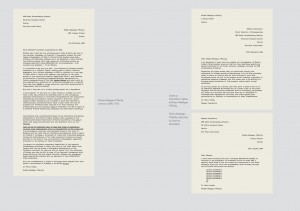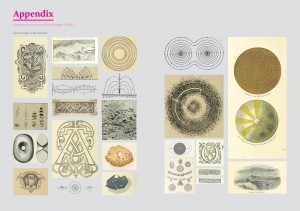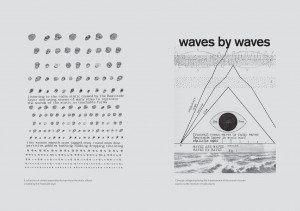Róisín Madigan O’Reilly
(b Dublin, 21 Jan. 1903; d Dingle, 13 Feb. 1974).
Manuscript Conservator, Composer and Founder of Primaudial Language Performances and Voweling The Heaviside.
Daughter to a German-born governess (E. Hessler) and an Irish Literature Lecturer, (E. O’Reilly) Madigan O’Reilly grew up speaking German, Irish and English and travelling sporadically to Potsdam to visit her mother’s affluent relations. Both her parents were staunch republicans. Her father wrote poems and articles for An Claidheamh Soluis and, aged just 13, Madigan O’Reilly became the youngest member of Cumann Na Mban, accompanying her mother to meetings. Madigan O’Reilly contributed to the struggle for Independence by gifting her first typewriter to Winifred Carney.
Adversely affected by the violence and unrest in Ireland during the Easter Rising and in Germany during the First World War, Madigan O’Reilly withdrew into her studies at the Dublin Metropolitan School of Art where she showed an aptitude for calligraphy, decorative lettering and illuminating. She took these traditional manuscript skills into unexpected territory such as bricolage and collage, often incorporating elements of her father’s poetry as visual elements. This unlikely application of traditional skills attracted the attention of the influential German publishing group Potsdam: Müller & Co. Verlag, who, in 1925, were completing a publication entitled Orientalisches Traumbuch von Mariette Lydis and wished to explore the possibility of a follow up with an Irish bias. In 1925 Madigan O’Reilly met with Irmgard Kiepenheuer to discuss Irisches Traumbuch von Róisín O’Reilly during which time she was exposed to the inaugural performance of Kurt Schwitters’ work Ursonate, the influence of which can be detected in her later projects including Os Ard.
The practical skills gained at the Dublin Metropolitan School of Art (see Every Woman’s Encyclopaedia) enabled Madigan O’Reilly to take a post in what has subsequently become the Preservation and Conservation department at Trinity Library. She worked there from 1925 up until 1958, contributing to several major conservation projects including the re-binding of the Book of Aicill and the Brehon Laws. A recent review of the manuscripts in the archives reveal that she may have added some exquisitely forged illustrations to some of the more obscure fifteenth century manuscripts held in the archives.
In 1926, Madigan O’Reilly developed an original Irish translation of Kurt Schwitters’ Ursonate entitled Os Ard and tried to persuade those in charge at 2RN to allow it to be broadcast on the airwaves. Surviving correspondence reveals that though the idea was proposed to Máiréad Ní Ghrádaa for consideration, the landmark broadcast which Madigan O’Reilly had envisaged never came to pass.
 In 1928, through mutual acquaintances at 2RN, Madigan O’Reilly met Edmund Madigan, a former civil servant radicalised during the uprising and reappointed to the Department of Posts & Telegraphs. In his new role he managed interval music and devised strategies for minimising interference on the frequency over which 2RN was broadcast. The two were married in 1930 and little is known of their marriage other than that they had no children; that Róisín insisted on keeping her father’s name as well as taking that of her new husband; and that Madigan died in 1950 and was buried with his treasured 3-valve radio set.
In 1928, through mutual acquaintances at 2RN, Madigan O’Reilly met Edmund Madigan, a former civil servant radicalised during the uprising and reappointed to the Department of Posts & Telegraphs. In his new role he managed interval music and devised strategies for minimising interference on the frequency over which 2RN was broadcast. The two were married in 1930 and little is known of their marriage other than that they had no children; that Róisín insisted on keeping her father’s name as well as taking that of her new husband; and that Madigan died in 1950 and was buried with his treasured 3-valve radio set.
In spite of her earlier setback with 2RN and perhaps influence by her husband’s work Madigan O’Reilly became increasingly fascinated by the medium of radio and particularly with the phenomenon of static which plagued broadcasting technologies of the time. She bequeathed a large collection of editions of Irish Radio Review to a colleague working in the BBC, along with scientific papers relating to the discovery and physics associated with the Heaviside Layer (see Appleton, E.V.; Ratcliffe, J.A.). It is thought that all of these artefacts were destroyed in the fire at Alexandra Palace which occurred in 1980 during Capital Radio’s Jazz Festival. Prior to this tragic loss notes scrawled on Rose’s magazines prompted speculation that Madigan O’Reilly submitted complaints to 2RN radio station under the pseudonym “Antenna” as a passive-aggressive response to the station’s conservative responses to her radical broadcast propositions. There was also evidence that she was a lifelong member of the Irish Radio Transmitters Society from its beginnings in 1932.
During the 1930s, Madigan O’Reilly and her husband accompanied her friend Máire Ní Chinnéide to the Blasket Islands, providing technical support to Ní Chinnéide’s intention to collect and record the stories of Peig Sayers.
Following her husband’s death, Madigan O’Reilly once again withdrew into her work, finally retiring to Dingle to keep sight of her beloved Blasket Islands and to complete work on Irisches Traumbuch von Róisín O’Reilly. She drifted into an esoteric hermitage, dedicating the last decades of her life to developing PrimAUDial Language Performances and Voweling the Heaviside. These works explored relationships between the vowel sounds of the Irish language, the sounds produced by natural forces such as the wind and the sea, and the poetic and physical links between the movement of both ocean and radio waves. PrimAUDial Language Performances were ephemeral happenings conducted a cappella in the landscape while Voweling the Heaviside was a determined effort to get the vowel sounds of the Irish language resounding around the ionosphere perpetually by means of long-wave transmission. It is thought that successful broadcasts of Irish vowel sounds over long-wave frequencies inspired the 1955 fictional story by Lord Dunsany, The Ghosts of the Heaviside Layer.
Due to their ephemeral nature very few of Madigan O’Reilly’s works from this time survive but several fragments still exist including:
- sketch for writing vowel sounds onto sand and performing them into a prevailing wind
- concept collage exploring the transmission of the sound of ocean waves via the medium of radio waves
- a collection of stones assembled to reproduce the static effects created by the Heaviside layer (the stones are held in the private estate of Róisín Madigan O’Reilly but here are notes explaining their use)
- a map noting listening places around The Blasket Islands
- two mysterious collages including illuminated lettering, Irish calligraphy, feathers from seabirds known to dwell on Great Blasket Island, and pages of scientific journals relating to radio transmissions and the Heaviside layer
SELECT BIBLIOGRAPHY:
Appleton, E.V.; Ratcliffe, J.A. (1929). The Physical Principles of Wireless. York: Methuen.
Augusteijn, J. (ed.). 2002. The Irish Revolution, 1913–1923, Houndmills, England: Palgrave
Dunsany. Ld., Schweitzer. D. (ed). 1980. The Ghosts of the Heaviside Layer, and Other Fantasms, Philadelphia: Owlswick Press
Ford, F. (2014). Voweling the Heaviside. Historical Documents of the Irish Avant-garde.
Gorham, M. (1967). Forty Years of Irish Broadcasting. Dublin: Talbot Press Ltd.
Mariette, L. (1925). Orientalisches Traumbuch von Mariette Lydis, Potsdam, Germany: Müller & Co. Verlag
Various. (1901). Census, available at http://www.census.nationalarchives.ie/pages/1901/ [accessed on 13/11/14].
Various. (1910 – 1912). The Arts – Where To Study Art – The Metropolitan School Of Art, Dublin, In: Every Woman’s Encyclopaedia, London: S.N.
Appendix: Image archives, correspondence




